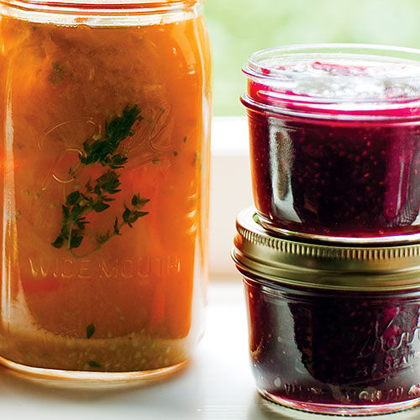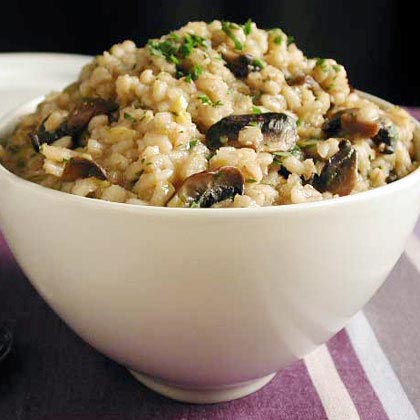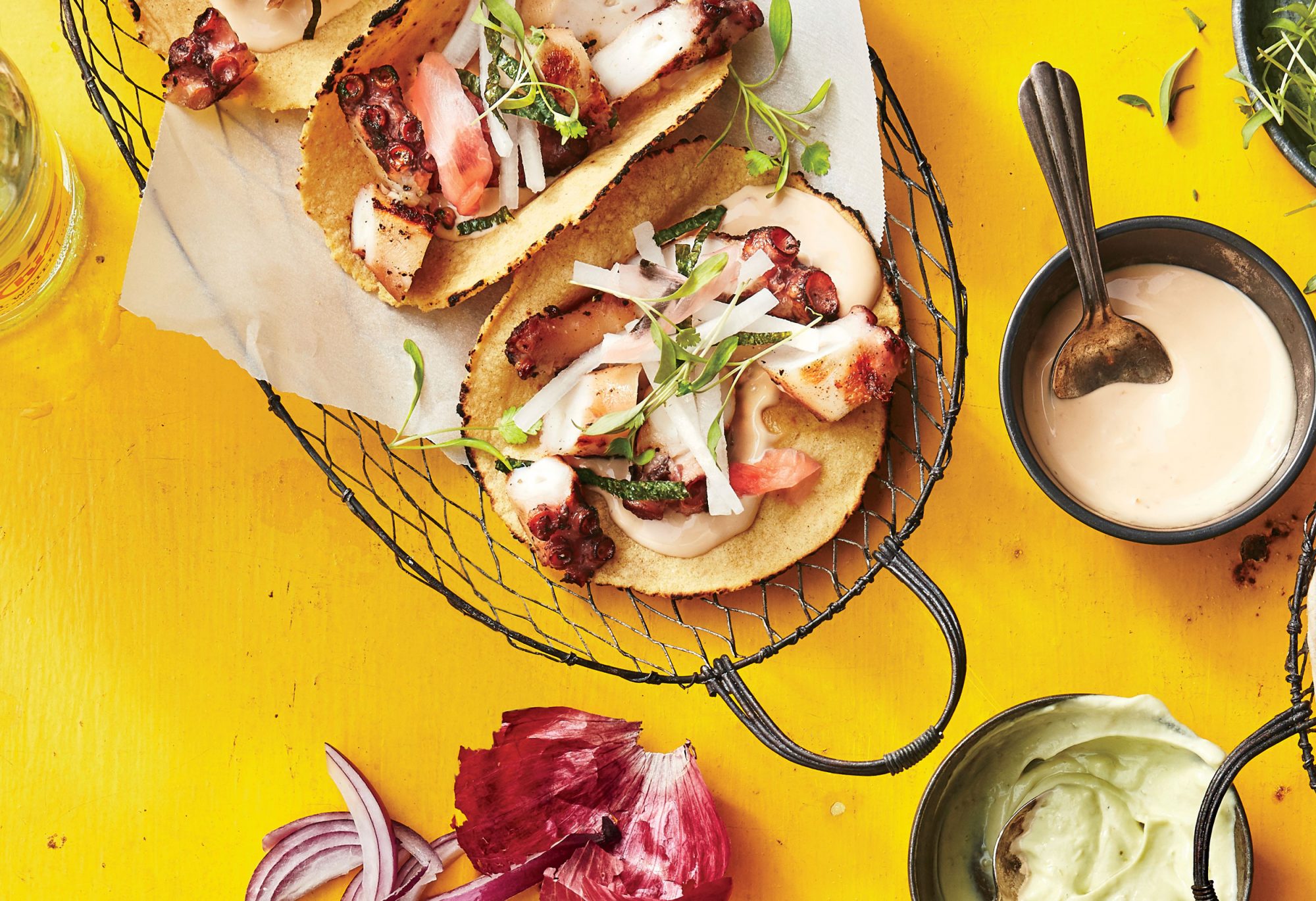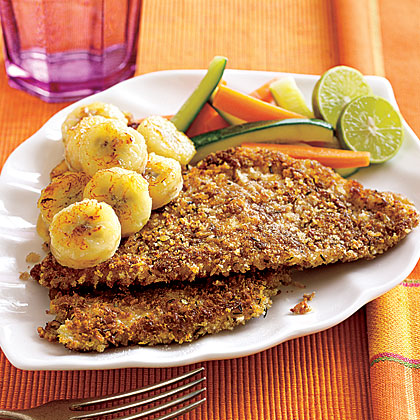Raspberry Blackberry Jam
Bookmark this page

Ingredients
3 cups (12 oz) blackberries
2 ½ tsp (2 2/3 pounds) raspberries
5 cups sugar, divided
1 pc (1.75 oz) Pectin with added jelly labeled "for recipes with or without less sugar".*
½ teaspoon butter* (optional)
To make
This sweet and tart jam has a bright raspberry flavor with enough blackberries added for a rich shade.
Follow the instructions in the "ABC of Canning: Cooking" section (below). Use 8 regular or half-pint wide-necked cans, or 4 pint cans, along with matching rings and lids.Meanwhile, puree the blackberries in a food processor. Rub through a fine sieve over the bowl to squeeze out as much juice as possible. Remove the seeds and scrape the juice into an 8-to 10-liter pot. Add the raspberries and mash very coarsely with a potato masher.Measure 4 3/4 cups sugar into a bowl; set aside. Pour the remaining 1/4 cup sugar into another bowl and stir in the pectin. Pour the pectin mixture into the pan with the berries and add the butter if desired.Bring the berry mixture to a full boil over high heat, which you can't reduce by stirring constantly with a long-handled spoon and keeping your hands away from splashes. Add the remaining sugar and bring to a full boil, stirring constantly. Cook, stirring, for exactly 1 minute.Fill the cans: Follow the instructions in the "Canning ABC: Fill and Seal the Cans" section, leaving 1/4 inch remaining. free space. Wipe the sides and cover with lids and rings, as indicated in the instructions.Cook as directed in the "ABC of Canning: Process Cans", simmer for 5 minutes (cook for 10 minutes at an altitude of 1001 to 6000 feet, 15 minutes above 6000 feet). If you can't fit all the cans on your canning shelf at once, process them in two batches. Cool, check for leaks, and store as directed (up to 1 year).* Do not use regular jelly for this recipe. Butter prevents the formation of foam during cooking. If you are not cooking it, remove the foam before pouring the jam into the jars.FIRST-TIME TIP: Add the sugar to the boiling berry mixture (step 4) all at once; this will help the mixture thicken properly.ABC of canning:PREPARE:Assemble the equipment: cans for canning with suitable metal lids and rings, a container for boiling water with a grate, a funnel with a wide throat, tongs and a lift for cans. Most hardware stores have these basics.Fill the tin with water and warm it up. For pint and half - pint cans, the container should be two-thirds full, for quart cans-half full. Place the grate on the side of the mold and cover the mold. Bring the water to a boil over high heat (180 ° to 185 ° for pickles); this will take 30-45 minutes.Meanwhile, wash the cans and rings in the dishwasher and wash the lids by hand; drain. Just for jam, also sterilize the washed jars: when the water in the jar boils, put the jars on the grill, lower them into the water and boil for 10 minutes. Reduce the heat to a simmer and let the jars soak in water until needed.Place the lids in rings in a saucepan and cover with water. Heat until small bubbles form (do not boil). Remove the pan from the heat and cover.Rinse the food, then cook according to the recipe instructions.FILL AND SEAL THE JARS:Pour the products into the cans through a wide funnel or spread them out with your fingers, leaving the free space (the distance between the edge of the jar and the products) specified in the recipe. If the last jar is not fully filled, allow to cool, then serve or refrigerate; do not recycle.Release the air bubbles to make a large mass: carefully swipe the knife inside the cans. Wipe the edges of the cans and threads with a clean, damp cloth so that the lids close tightly.Center the lids on the cans so that the sealant on the lids touches the edges of the cans. Tighten the metal rings tightly, but do not apply pressure.PREPARING BANKS:Put the cans on a wire rack in the water. Water should cover the jars by at least 1 inch; add hot water as needed during processing. Close the jar and bring the water to a boil. Cook for the time specified in the recipe.Lift the rack of cans to the edge of the tin pan, using tongs and a reheating rack. Use the can lift to transfer the cans to towels on the work surface. Do not tighten the rings. Allow to cool completely at room temperature. You can hear the "ping" when the banks close.Press down on the middle of each lid. If it doesn't cool down, then the jar is sealed. If it pops up, it's not (you can still eat the dish — chill it as if it were leftovers). Label the jars and store them in a cool, dark place for up to 1 year.Note: The nutritional value analysis is based on 1 tablespoon of water.
Follow the instructions in the "ABC of Canning: Cooking" section (below). Use 8 regular or half-pint wide-necked cans, or 4 pint cans, along with matching rings and lids.Meanwhile, puree the blackberries in a food processor. Rub through a fine sieve over the bowl to squeeze out as much juice as possible. Remove the seeds and scrape the juice into an 8-to 10-liter pot. Add the raspberries and mash very coarsely with a potato masher.Measure 4 3/4 cups sugar into a bowl; set aside. Pour the remaining 1/4 cup sugar into another bowl and stir in the pectin. Pour the pectin mixture into the pan with the berries and add the butter if desired.Bring the berry mixture to a full boil over high heat, which you can't reduce by stirring constantly with a long-handled spoon and keeping your hands away from splashes. Add the remaining sugar and bring to a full boil, stirring constantly. Cook, stirring, for exactly 1 minute.Fill the cans: Follow the instructions in the "Canning ABC: Fill and Seal the Cans" section, leaving 1/4 inch remaining. free space. Wipe the sides and cover with lids and rings, as indicated in the instructions.Cook as directed in the "ABC of Canning: Process Cans", simmer for 5 minutes (cook for 10 minutes at an altitude of 1001 to 6000 feet, 15 minutes above 6000 feet). If you can't fit all the cans on your canning shelf at once, process them in two batches. Cool, check for leaks, and store as directed (up to 1 year).* Do not use regular jelly for this recipe. Butter prevents the formation of foam during cooking. If you are not cooking it, remove the foam before pouring the jam into the jars.FIRST-TIME TIP: Add the sugar to the boiling berry mixture (step 4) all at once; this will help the mixture thicken properly.ABC of canning:PREPARE:Assemble the equipment: cans for canning with suitable metal lids and rings, a container for boiling water with a grate, a funnel with a wide throat, tongs and a lift for cans. Most hardware stores have these basics.Fill the tin with water and warm it up. For pint and half - pint cans, the container should be two-thirds full, for quart cans-half full. Place the grate on the side of the mold and cover the mold. Bring the water to a boil over high heat (180 ° to 185 ° for pickles); this will take 30-45 minutes.Meanwhile, wash the cans and rings in the dishwasher and wash the lids by hand; drain. Just for jam, also sterilize the washed jars: when the water in the jar boils, put the jars on the grill, lower them into the water and boil for 10 minutes. Reduce the heat to a simmer and let the jars soak in water until needed.Place the lids in rings in a saucepan and cover with water. Heat until small bubbles form (do not boil). Remove the pan from the heat and cover.Rinse the food, then cook according to the recipe instructions.FILL AND SEAL THE JARS:Pour the products into the cans through a wide funnel or spread them out with your fingers, leaving the free space (the distance between the edge of the jar and the products) specified in the recipe. If the last jar is not fully filled, allow to cool, then serve or refrigerate; do not recycle.Release the air bubbles to make a large mass: carefully swipe the knife inside the cans. Wipe the edges of the cans and threads with a clean, damp cloth so that the lids close tightly.Center the lids on the cans so that the sealant on the lids touches the edges of the cans. Tighten the metal rings tightly, but do not apply pressure.PREPARING BANKS:Put the cans on a wire rack in the water. Water should cover the jars by at least 1 inch; add hot water as needed during processing. Close the jar and bring the water to a boil. Cook for the time specified in the recipe.Lift the rack of cans to the edge of the tin pan, using tongs and a reheating rack. Use the can lift to transfer the cans to towels on the work surface. Do not tighten the rings. Allow to cool completely at room temperature. You can hear the "ping" when the banks close.Press down on the middle of each lid. If it doesn't cool down, then the jar is sealed. If it pops up, it's not (you can still eat the dish — chill it as if it were leftovers). Label the jars and store them in a cool, dark place for up to 1 year.Note: The nutritional value analysis is based on 1 tablespoon of water.
Views: 185
Author:Admin
Published: 11/20/2023 8:57 PM
Was this recipe helpful to you?
Yes
No






Comments (0)